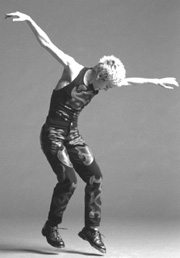IF LISTENING TO MOZART is supposed to make us more intelligent, then seeing and hearing Sandy Silva should make us supersmart. One of the last times I saw Silva perform I sat, literally, at her feet. She appeared at the end of a mixed bill at the old New City Theater and decided to perform in the lobby; I crouched down in order to let the people behind me get a look and went for a wild ride as she pounded the floor. Last week in On the Boards’ cozy Studio Theater I sat in a regular seat, but the trip thrilled me as much as it had before.
Sandy Silva and Friends
October 14 at On the Boards
Silva bills herself as a percussive dancer, and her work has flashes of tap, step dancing, clogging, hambone, and even flamenco. Her gift is in the combining of these elements. She frequently alternates between the full-footed hammering of step dancing and the more detailed heel-and-toe articulation of rhythm tap. Sometimes the power of her foot on the stage rebounds and sends her up in the air like a rocket. Other times she bends down low, coaxing the rhythm from the floorboards. She dances like an angel or a bat straight from hell. Occasionally, toward the end of a long sequence, she’ll give herself a little shake, not unlike a dog shaking off water, and plunge into the rhythm again. She often works with her eyes half-shut, listening to the interplay of her patterns and the music, then opens wide for a special riff or burst of traveling steps.
Percussive dancers can play a more musical than physical role (indeed, Silva actually served as a seated human percussion section for one tune), and their challenge is to find the dance movement attached to the sounds. Some performers are purely reactive, their movement designed only to generate their complex rhythms; the joy in watching them comes from their elegant efficiency. It’s rather like a superb athlete sinking a basket, using just enough effort but no more. Other dancers are more intricate stylists, mirroring or elaborating on a rhythmic sequence with a counterpoint of carefully placed gestures. Silva incorporates both approaches, sometimes creating floor plans and gestural sequences fully as complex as the musical structure. And sometimes she just rides on waves of sound.
SILVA USED TO project a kind of waiflike quality as a performer, but since she’s been away from Seattle she’s become stronger and leaner. She’s spent the last few years in Quebec, touring with traditional music groups like La Bottine Souriante, but her set here is more eclectic than pure. In her current show, she’s a powerhouse on stage, her halter top and red leather pants giving added intensity to her already vivid presence. Her musicians segue from straightforward Irish and American folk tunes to Romanian and Hungarian songs in tricky meters. Fiddler Ruthie Dornfeld and Forrest Gibson on guitar were especially fine, but Ruth Hunter, singing and playing the accordion, was astonishing. Her vocal quality was at once soothing and terrifying in songs like “Stojan na Stanka,” describing a mother’s grief at losing her children.
Silva’s show opened with an elaborate circling dance, tapping in silence, and closed with an ebullient encore. In between were miles of wonderful dancing, playing sassy rhythmic games and linking our pulse with the movement. The word is that Silva has signed with a local agent—if that means that we see more of her in Seattle again, the word is good indeed.








